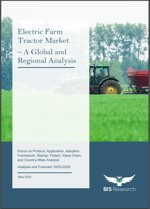 The agricultural industry is undergoing a significant transition as it embraces the power of electric technology. Electric farm tractors, with their efficiency, sustainability, and potential cost savings, are becoming a key focus for farmers and industry experts.
The agricultural industry is undergoing a significant transition as it embraces the power of electric technology. Electric farm tractors, with their efficiency, sustainability, and potential cost savings, are becoming a key focus for farmers and industry experts.
According to BIS Research, the global electric farm tractors market is estimated to reach an impressive $234 million by 2028, from $98.7 million in 2022, with a CAGR of 14.06% during the forecast period 2023-2028, signifying a paradigm shift in modern farming practices.
This article explores the factors driving the market value to an exponential figure and the significant opportunities ahead for farmers and agribusinesses.
1. Advancements in Battery Technology Drive Growth of Electric Tractors
Advancements in battery technology are fueling the growth of electric tractors in the agricultural industry. Lithium-ion batteries, owing to their increased energy storage capacity and affordability, are leading the way. Innovations such as gold nanowires as electrodes and solid-state batteries offer improved performance, safety, and durability.
Moreover, emerging battery chemistries show promise for electric tractors, such as sodium-ion batteries and sodium-sulfur batteries.
In 2023, the market expects breakthroughs in lithium iron phosphate cathodes, silicon-based anodes, and the commercialization of solid-state batteries. The continuous progress in battery technology is essential for achieving lower costs, faster charging, and longer driving ranges, thereby driving the adoption of electric tractors.
2. Enhanced Operations with 5G Network and LoRaWAN
The implementation of 5G networks is expected to enable faster data rates, supporting machine-to-machine communication and Internet of Things (IoT) applications in agriculture. It is estimated that improved rural 5G coverage can boost long-term GDP in the agriculture sector by up to 1.8%.
With 5G, large-scale farms can leverage centralized data aggregation, real-time monitoring, and predictive analytics to enhance productivity and efficiency. Moreover, the high bandwidth and low latency of 5G facilitate the transmission of high-quality video data and enable autonomous vehicles such as tractors to exchange large amounts of data.
Meanwhile, long range wide area network (LoRaWAN) provides a low-power, long-range wireless communication protocol for tractors, enabling real-time monitoring of performance, precision agriculture practices, and remote control of tractor parameters.
3. Increasing Role of Climate-Smart Agriculture Practices
Electric farm tractors produce zero direct emissions during operation, promoting climate-smart agriculture practices. By integrating renewable energy sources, such as solar or wind power, farmers can further reduce their reliance on fossil fuels for energy generation in vehicles.
Moreover, the integration of electric tractors with precision agriculture technologies would allow for precise and efficient application of inputs, minimizing waste and improving resource management. This would further result in increased productivity, reduced environmental impact, and improved resilience to climate variability.
4. Growing Adoption of Electric Vehicles
Governments worldwide, such as Norway, the U.S., and China, are introducing incentives and subsidies to bridge the price gap between EVs and conventional vehicles, thereby stimulating the initial adoption of electric light commercial vehicles.
In the agricultural sector, the push toward electric farm tractors is being driven by concerns over atmospheric pollution caused by combustion engine tractors. Governments in regions such as the U.S. and the European Union have launched programs and initiatives to support the development of public charging infrastructure, ensuring convenient and affordable access to charging stations as the number of EVs increases.
Moreover, according to the International Energy Agency (IEA), electric tractors may represent around 35% of all tractor sales in India and approximately 20% of total tractor sales in China by 2040. These estimates assume that electric tractors will become financially competitive with traditional tractors in the near future.
Financial grants and tax exemptions are provided to charging station operators and construction projects, which are expected to fuel the demand for electric farm tractors, contributing to the growth of the market in the forecast period.
5. Growing Compatibility with Other Technologies
Electric farm tractors are getting increasingly compatible with advanced technologies, such as GPS guidance systems, variable-rate technology, automatic steering systems, and telematics. This compatibility would allow for precise field mapping, optimized seed planting and fertilizer application, autonomous navigation, and remote monitoring and control.
By integrating these technologies, electric tractors can enhance efficiency, productivity, and safety in modern farming practices. They enable data-driven decision-making, reduce costs, and optimize energy consumption.
Conclusion
The positive public perception of sustainable farming practices, along with the increasing demand for organic and locally sourced produce, would provide an additional incentive for farmers to transition to electric farm tractors. Electric tractors would further enable farmers to align their operations with consumer preferences, gaining a competitive edge in the market.
Learn More
 For more information on this fast-growing market, please see Electric Farm Tractor Market – A Global and Regional Analysis, a detailed report packed with data and insights covering electric farm tractor market segmentation, recent market developments, market demand, drivers and challenges, the competitive landscape, and key players. This report draws on extensive primary and secondary research to help industry players design the right business strategies for this competitive, ever-shifting market.
For more information on this fast-growing market, please see Electric Farm Tractor Market – A Global and Regional Analysis, a detailed report packed with data and insights covering electric farm tractor market segmentation, recent market developments, market demand, drivers and challenges, the competitive landscape, and key players. This report draws on extensive primary and secondary research to help industry players design the right business strategies for this competitive, ever-shifting market.
About the Publisher: BIS Research is a global market intelligence, research and advisory company that focuses on emerging technology trends that are likely to disrupt the market. Its team includes industry veterans, experts, and analysts with diverse backgrounds in consulting, investment banking, government, and academia.








